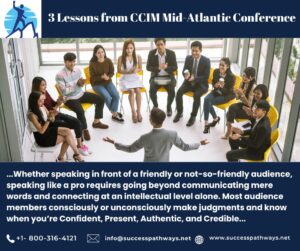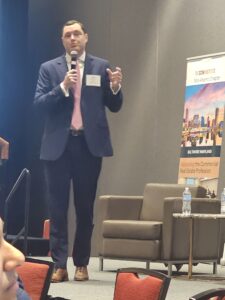16 Jan Public Speaking Lessons from the CCIM Mid-Atlantic Conference
Abraham Maslow was right! ‘When your only tool is a hammer, it is tempting to treat everything as if it were a nail.’
 As a learning professional who trains and coaches leaders to speak like a PRO, whenever I attend events, my mind is busy in the background evaluating how the speakers on the stage or in the webinar are performing.
As a learning professional who trains and coaches leaders to speak like a PRO, whenever I attend events, my mind is busy in the background evaluating how the speakers on the stage or in the webinar are performing.
The CCIM Mid-Atlantic conference this past Friday, January 12, 2024, wasn’t exceptional.
The people who sat next to me can testify. I was sitting there glued, listening to everything said on the stage. I was:
- Listening actively,
- Taking pictures of slides, and
- Writing down notes.
Regardless, I couldn’t stop my mind from assessing the performance of speakers and panelists.
In this blog, I’d like to share three things that went very well for many speakers and a few areas that need improvement.
The goal of this blog is specific. I’m writing this blog for those who want to improve and take their speaking abilities to the next level by learning from other speakers’ experiences.
- You don’t need to reinvent the wheel.
- You shouldn’t also repeat the same mistakes other speakers make.
I’m using this opportunity to share with you some lessons so that when you speak next time, you know what to incorporate and avoid in your next speech and beyond.
I. Let’s start with what went very well:
1. Confidence, Presence, Authenticity, and Credibility. You don’t need to be a trainer and coach like me to realize that all speakers knew what they were talking about, were excited to be there, ‘present’ on the stage, and shared valuable information.
A quick disclaimer. The speakers and panelists faced a friendly crowd. The attendees were professionals within the same industry who came together to connect and learn from one another.
When you’ve such a friendly audience, you aren’t speaking against the current.
- Many of the attendees might already know you.
- Most of them are familiar with your experience and story.
- Most of all, they’re friendly and cheering for you to succeed.
 You may not have such a home-court advantage when you speak in front of strangers.
You may not have such a home-court advantage when you speak in front of strangers.
- All may not cheer up for you.
- Sometimes, you may face unfriendly audiences, even a few hacklers.
When you speak in front of strangers, the stakes are high.
- You have 30 seconds or less to establish yourself as an authentic speaker.
- You’ve to build your credibility from scratch.
- Otherwise, you’ll lose many audience members within the first 60 seconds, and you may never hook them back before you conclude your speech, especially if your speech is 10 – 30 minutes long.
Whether speaking in front of a friendly or not-so-friendly audience, speaking like a pro requires going beyond communicating mere words and connecting at an intellectual level alone.
Most audience members consciously or unconsciously make judgments and know when you’re:
- Confident,
- Present,
- Authentic, and
- Credible.
If they find you otherwise, they may check out immediately and never connect with you at a deeper level.
When that happens:
- You are unable to meet your and your organization’s goals.
- You can’t help your audience significantly.
- You won’t be able to change their minds and hearts, your ultimate goal as a speaker.
That is why speakers should do their homework well before stepping on the stage or sitting in front of the camera. They should be emotionally present and engage their audience on multiple levels:
- Intellectually,
- Emotionally, and
- Heart levels.
2. Stories and Metaphors. We are all humans. Regardless of our diverse backgrounds, cultures, and preferences, we LOVE stories, metaphors, and analogies. At this conference, stories were shared, many of which resonated with me and, I believe, with many of the audience, too.
More than the insightful data and stats shared, I remember the stories and metaphors. For instance, I still remember the metaphor one of the speakers used throughout his presentation, which made it easy for me to understand his message, and I vividly remember the key takeaways.
Data, stat, and facts are equally important. However, speakers who back their insights, data, and stats with stories, metaphors, and analogies persuade and influence more than those who don’t.
3. PowerPoint Slides. One of the frustrating things I consistently observe is the use of boring slides that hinder speakers’ success, especially in technical industries. Some speakers assume that the more data they jampack in a slide, the better. They also put tones of texts and read from the slides, making it hard for the audience whether they should listen to the speaker or read what is on the slides.
 I was impressed by the PowerPoint slides of the speakers at this conference.
I was impressed by the PowerPoint slides of the speakers at this conference.
- They used more images and less text.
- Each slide was also easy to absorb within a few seconds.
- Each slide represented a concept and communicated a clear, singular message.
In our 1-day and 2-day hands-on public speaking workshops, we give participants a formula to test whether their PowerPoint slides support their presentation or distract their audience. The slides at this conference followed our formula 🙂
II. Here are a couple of areas that need improvements:
1. Movement on the stage. The keynote speakers avoided the podium- a smart move. Experienced speakers don’t ‘hide’ behind a podium unless the setup forces them. They don’t allow the podium to become a barrier between them and their audience.
Nonetheless, one of the speakers was moving constantly. Inexperienced speakers channel nervousness through moving too much. This wasn’t the case, though. It wasn’t a restless movement. I’m assuming this is a conscious choice from the speaker’s side. It could be to reach every audience at every corner. I get it. As far as the speaker is consciously aware of what was happening and how his movement could potentially distract some audience members, it is okay.
We teach our participants and coachees to avoid moving too much since it could distract their audience. Our advice is to move within reasonable intervals and purposefully. Using strategic eye contact, a speaker doesn’t need to move too much to connect with the entire audience in large conference rooms.
2. Q&A session. Many speakers and event organizers undermine the critical place of the Q&A session. It is an afterthought. However, the Q&A session can make or break a speaker’s overall performance. If a speaker performs casually and poorly during this session, he/she may finish poorly and ruin the entire speech.
We warn our clients to give equal importance to the Q&A session. We advise them to leverage and take advantage of the last section of their presentation strategically to strengthen the preceding speech further and finish on a high note.
During the Q&A sessions, one of the advice we offer to our clients wasn’t followed. Questions weren’t repeated before answering them.
Some of the participants were not using the mic because they believed that their voices were so powerful that anyone in any corner of that large room could hear them. They didn’t realize that people behind them and at the far corners of the room may not hear them at all or cannot fully hear their entire question.
The speakers and panelists who had the mic should have repeated each question for the benefit of all other participants before answering.
3. Mic. The two main speakers handled the hand-held mic very well by bringing the mic closer when they spoke. Some of the panelists and others who used the podium mic didn’t speak closely to the mic sometimes, and it was hard to hear what they had to say once in a while.
The best approach would have been using Lavalier microphones. On top of solving the problem I just mentioned, this would have allowed the keynote speakers to employ both hands to maximize their communication.
 Lastly, I was surprised that the event wasn’t recorded. If we ignore the thousands of dollars value of using the recorded video for branding and marketing purposes for both CCIM and the chapter, the speakers and panelists would have benefited if the event had been recorded.
Lastly, I was surprised that the event wasn’t recorded. If we ignore the thousands of dollars value of using the recorded video for branding and marketing purposes for both CCIM and the chapter, the speakers and panelists would have benefited if the event had been recorded.
Though I’m now advanced in my public speaking journey and help others improve their public speaking skills, whenever clients allow me, I ask them to record my presentations or permit me to record them myself. I’ll watch my speeches and self-critic them. I also send it to my mentors and colleagues to give me feedback.
As a speaker, you should never feel you have ARRIVED. You should constantly improve your speaking competencies by auditing yourself and getting feedback from other experienced speakers.
Let me stop here…
Hope this blog has been helpful. If you would like to dive deep, please reach out. We have a coaching program called “Speaking Like a PRO.”
We can also arrange a 1-day or 2-day workshop for your team. Let’s custom design and deliver this workshop for your people. It doesn’t matter if you’re an extraordinary communicator on the stage and in front of a webcam. You need everyone on your team to excel in their public speaking.
Here are the most important benefits of empowering your team members and leaders to speak like a PRO:
- Express themselves and communicate with all stakeholders very well.
- Represent your company and brand better.
- Understand and be understood by the existing clients.
- Win new prospective clients.
- Avoid unwanted consequences that may come from miscommunication, communication breakdown, and misunderstanding, such as conflicts.
- And many more benefits…
To learn more about our Speaking Like a PRO program, click here…
If you have any questions or would like to schedule a one-on-one Zoom chat to learn more about our programs, reach out to our team via [email protected]
#powerofthepin #ccimmidatlantic #ccim #publicspeaking
